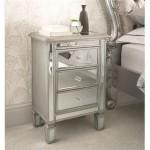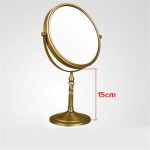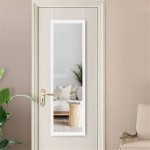Antique Gilded Mirrors: A Reflection of History and Artistry
Antique gilded mirrors offer a glimpse into the past, showcasing the craftsmanship and artistic trends of bygone eras. More than mere reflective surfaces, these pieces served as status symbols, decorative focal points, and even expressions of personal taste. Understanding their history, construction techniques, and various styles can significantly enhance their appreciation and value for collectors and enthusiasts alike.
Key Aspects of Antique Gilded Mirrors
*
Historical Context:
Gilded mirrors have adorned homes since the ancient Egyptians, who used polished metals like bronze and copper. Later, the Romans adopted similar practices. However, true gilding, using thin sheets of gold applied to a base material, gained prominence during the Renaissance. *Materials and Techniques:
Traditional gilding involved applying gold leaf, a delicate process requiring specialized skills. Alternative materials like silver or copper gilding were also employed for affordability. The base material for the frame typically consisted of wood, often carved with intricate designs. *Styles and Periods:
The design and ornamentation of gilded mirrors evolved through different periods, reflecting the prevalent artistic styles. From the ornate Baroque and Rococo to the simpler Neoclassical and Victorian, each era left its distinct mark.The Art of Gilding: A Delicate Process
The creation of a gilded mirror was a multi-step process requiring significant skill and precision. The process began with preparing the frame, which involved carving and smoothing the wood. Next came the application of gesso, a mixture of chalk and animal glue, to provide a smooth surface for the gold leaf. Once the gesso dried, the gilder carefully applied thin sheets of gold leaf using specialized tools and adhesives. Burnishing, using agate or other hard stones, polished the gold to a brilliant sheen. Finally, a protective layer of varnish was applied to preserve the delicate gold leaf.
Identifying Antique Gilded Mirrors
*
Examining the Gilding:
Observing the gilding itself can reveal clues about its age and authenticity. Wear patterns, patina, and the presence of repairs are all indicative of age. The type of gold used, whether 22k, 23k, or other karats, also provides insights. *Frame Construction and Design:
The construction techniques, joinery, and the wood type used in the frame can point to the period of manufacture. Hand-carved details, as opposed to molded ones, are often a sign of an earlier and potentially more valuable piece. *Backings and Mirror Plate:
Examining the mirror's backing and the reflective plate itself can offer further evidence. Older mirrors often have mercury-backed glass, which develops a distinctive speckled appearance over time. Later mirrors may have silvered glass.Styles Across the Centuries
*
Baroque and Rococo (17th-18th Centuries):
These periods are characterized by opulent and elaborate designs. Gilded mirrors from these eras feature intricate carvings, often incorporating motifs like shells, scrolls, and floral elements. Asymmetry and a sense of movement are common characteristics. *Neoclassical (Late 18th – Early 19th Centuries):
Reacting against the excesses of the Baroque and Rococo, Neoclassicism embraced simpler, more geometric designs. Gilded mirrors of this period exhibit cleaner lines, symmetrical compositions, and classical motifs like urns, swags, and columns. *Victorian (19th Century):
The Victorian era witnessed a resurgence of ornamentation, though generally less extravagant than the Baroque. Gilded mirrors from this time often incorporate floral motifs, gothic arches, and elaborate frames. Eclecticism, blending different styles, was also common. *Art Nouveau and Art Deco (Late 19th - Early 20th Centuries):
These styles brought new aesthetic sensibilities to gilded mirrors. Art Nouveau embraced flowing lines and organic forms inspired by nature, while Art Deco favored geometric shapes and stylized designs.Caring for Antique Gilded Mirrors
*
Dusting and Cleaning:
Regular dusting with a soft brush is essential. Avoid using abrasive cleaners or excessive moisture, as these can damage the delicate gilding and the mirror plate. *Handling and Storage:
Handle antique gilded mirrors with care, supporting the frame and avoiding contact with the gilded surface. If storing, wrap them in acid-free tissue paper or soft cloth. *Environmental Considerations:
Avoid placing gilded mirrors in direct sunlight or areas with high humidity, as these conditions can accelerate deterioration. Extreme temperature fluctuations should also be avoided. *Professional Restoration:
For significant damage or restoration work, it is recommended to consult a qualified conservator experienced in gilding techniques. Attempting repairs without the necessary expertise can cause further damage.The Value and Appeal of Antique Gilded Mirrors
*
Historical Significance:
Antique gilded mirrors represent tangible connections to the past, reflecting the artistic and cultural values of their respective eras. *Artistry and Craftsmanship:
These pieces showcase the skill and dedication of artisans who mastered the intricate techniques of gilding and frame making. *Decorative Appeal:
Antique gilded mirrors add a touch of elegance and sophistication to any interior, serving as both functional objects and works of art. *Investment Potential:
Authentic antique gilded mirrors, particularly rare or highly decorative examples, can hold significant value and appreciate over time.
The Annecy Mirror Antique Gold 4ft High 209 00 Mirrors Cau Luxury Furniture And Rococo Reion Baroque French Style Specialist

Oversized Full Length Mirror Antique Gold Handmade French Era Inspired 19th Century Design Stand Alone Show Stopper

Flophouze Container Hotel Magnificent Antique Gold Gilt And Plaster Mirror

Gold Antique Style Mirror Kirklands Home

Antique Hand Carved Italian Mirror

Marley Forrest Medium Rectangle Antique Gold Leaf Classic Mirror 34 In H X 49 W 84001 The Home Depot

Antique Gilt Pier Mirror Overmantel Over Mantel Gold Carved Antiques Georgian Furniture Regency Victorian

Large 19th Century Gold Mirror With Volutes And Flowers Leaf Frame 1880s For At Pamono

Antique Gold Gilded Mirror Beveled 21 X 37 Wonderful Condition Long Valley Traders

Anthropologie Inspired Diy French Gold Mirror So Much Better With Age








